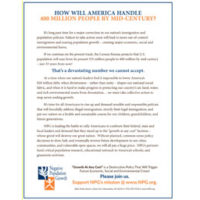Ever Increasing Immigration is Not Necessary to Keep U.S. Economy Growing
- NPG
- September 12, 2017
- Press Releases
- 0 Comments
 Your gift helps publish and distribute materials like this.
Your gift helps publish and distribute materials like this.
Download a PDF of this release here.
This press release was distributed to thousands of media outlets across the country, including all major television networks. Together, NPG’s message was picked up by hundreds of outlets with a combined subscribed audience of over 185 million Americans.
Ever Increasing Immigration is Not Necessary to Keep U.S. Economy Growing
New NPG Paper Argues That Population Growth Creates a False Illusion of Prosperity
“It’s time to abandon the notion that a growing population equals a growing economy.” That’s the thesis behind a newly issued Forum Paper from Negative Population Growth (NPG), a national non-profit organization dedicated to reducing the size and growth of U.S. population. This new research is presented by Edwin S. Rubenstein in a paper titled: To Grow the Economy Increase Human Capital, Not the Number of Humans.
Rubenstein challenges those who promote the idea that America’s economy will falter without a steady flow of immigrants. He holds that the current theory that more immigration means more workers, which means – we need more immigration – is not sound. He argues the reality is that “GDP does indeed rise when new immigrants enter the labor force. But living standards are best measured by per capita income, not total GDP.”
By using Japan as an example, Rubenstein answers the question: Do we need any immigration?
He states: “Nations with stagnant or falling populations often enjoy faster per capita GDP growth than those with high immigration and population growth.” Japan has strict controls on immigration and while its population has declined in recent years… “the labor force is rising as older people rejoin the workforce and more women take jobs.” He continues by stating: “From 1960 to 2011 Japan’s per capita GDP, measured in 2011 dollars of fixed purchasing power, rose by a factor of 5.6-to-1, more than twice the 2.7-to-1 growth multiple recorded in the U.S.”
In contending that “population growth is not a good indicator of economic growth,” Rubenstein references a study conducted by the Martin Prosperity Institute that compared trends in population growth and productivity growth (as measured by economic output per capita) for the nation’s 366 metropolitan areas. The study found that “There is no connection between the two.”
For Rubenstein, cheap labor has its drawbacks – especially in postponing advancing technology. He notes: “The rapid transformation of the California tomato harvest – none were harvested by machine in 1960, and all were harvested by machine by 1970 – was expected to usher in an era of machines replacing men on farms. Economists and engineers predicted that by 2000 there would be practically no jobs left for unskilled seasonal farm workers. But with the onset of mass illegal immigration in the late 1970s, California farmers lost interest in agricultural innovation.”
In documenting his research with educational charts and graphs, Rubenstein presents a valid argument against increased immigration and economic growth. He highlights the disadvantages of America’s immigration system which is so heavily based on family ties, rather than economic skills. His charts on immigrant earnings by country of nativity and educational attainment are especially eye-opening.
Is America’s economy doomed to stagnate without mass immigration? For Rubenstein, the answer is a clear “no.” He concludes by stating: “Unlimited access to skilled foreign workers has diminished the need for U.S. employers to invest in capital – human and technological – for their native-born workers. As worker productivity falls, workers must work longer hours just to maintain their current standard of living. This vicious cycle has been at work for decades. A reduction in overall immigration levels, coupled with a vetting process that emphasizes human capital rather than family ties, could enhance both the quality and the quantity of U.S. economic growth.”
- EARTH DAY 2024 - April 15, 2024
- We owe it to future generations… - April 13, 2024
- New NPG Forum Paper Explores the Role of Migrant Labor in US Agriculture - April 11, 2024


